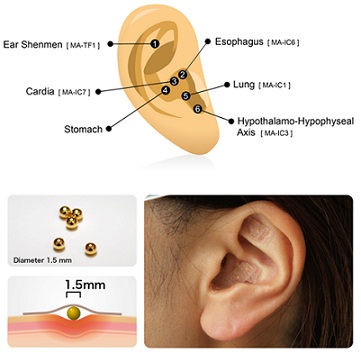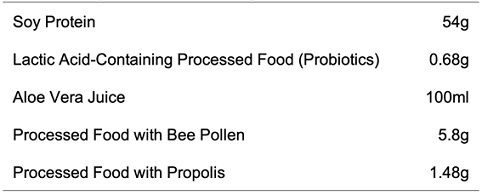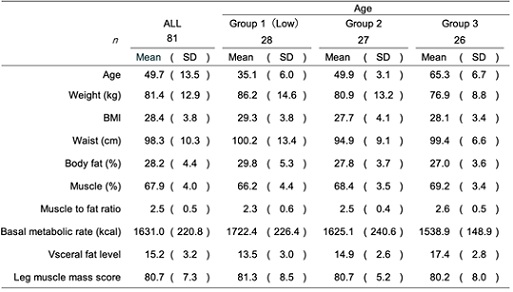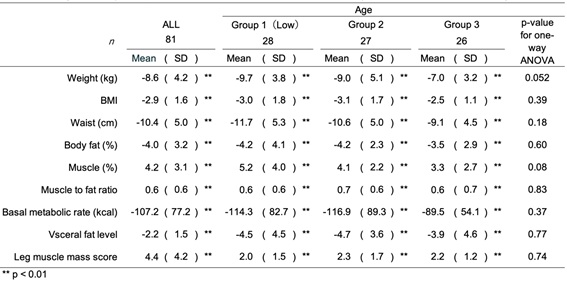
The Effectiveness of a Weight Loss Program Combining Auricular Stimulation and Nutritional Supplements in Japanese Men
*Corresponding Author(s):
Takahiro FujimotoClinic F, 1-8-12 Hirakawa-cho, Chiyoda-ku, Tokyo , Japan
Tel:+81 0332216461,
Email:fujimoto@clinic-f.com
Keywords
Acupuncture; Auricular Stimulation; Metabolic Syndrome; Sarcopenic Obesity; Weight Loss
Introduction
Obesity presents enduring health challenges among individuals leading modern lifestyles. Our society confronts an unprecedented surge in obesity, precipitating serious issues such as visceral fat accumulation, fatty liver disease, diabetes, cancer, and cardiovascular diseases [1]. Moreover, as economically developed countries experience prolonged healthy lifespans, age-related declines in both muscle mass and strength, coupled with the intersection of sarcopenia and visceral obesity, pose significant health challenges, including frailty and sarcopenic obesity.
In Japan, a weight reduction program combining auricular acupuncture stimulation using metallic beads and nutritional supplements has been practiced for over 30 years as a method to achieve weight loss while preserving healthy body composition. Auricular acupuncture stimulation is believed to enhance resistance to appetite, with documented usage in weight loss and drug withdrawal programs worldwide. Fujimoto et al. reported a 11.15% reduction in body weight over three months among female participants (n=1362) enrolled in this weight loss program [2]. However, the majority of previous research has focused on females, with limited studies targeting males.
The purpose of this study was to investigate whether combining auricular acupuncture stimulation and nutritional guidance could result in weight reduction among men with high visceral fat levels.
Methods
Auricular Stimulation Sites
As part of auricular meridian stimulation, 1.5mm metal beads were affixed to six designated points on both ears of the participants using tape. These points consisted of 1) Ear Shen Men, 2) Esophagus, 3) Cardia, 4) Stomach, 5) Lung, and 6) Endocrine. Throughout the measurement period, subjects received constant stimulation through the metal beads. The selection of these points was informed by previous research.
1) Ear Shen Men [MA-TF1 Earshenmen] stimulation reduces anxieties and pain and improves mood [3]; thus, presenting the anti-anxiety effect and anti-inflammatory effect [4]. 2) Esophagus and 3) cardia [MA-IC7 Benmen] stimulation regulates appetite and reduces body weight [5] while increasing the sensitivity to salty taste [6]. 4) Esophagus [MA-IC6 Shidao] and stomach [stomach] were selected to stimulate above and below the cardia because the center point can enhance cardiac function. 5) Lung [MA-1C1 Fei] stimulation increases satiety, reduces hunger, and reduces food consumption, leading to weight loss [7] and increasing the sensitivity to salty taste [6]. 6) Hypothalamo-hypophyseal axis [MA-IC3 Neifenmi] stimulation stabilizes the entire endocrine system through the pituitary gland [3]. Codes (MA followed by numbers) are acupuncture points with WHO/WPRO numbers. The use of hunger points has been reported in a previous study on AA to treat overweight people [8]. This point is located on the outside of the ear, and we excluded it, assuming that it would interfere with the subjects’ appearance in their daily lives. Anatomically, the afferent nerve is roughly divided into three types: 1) the auriculotemporal nerve [the trigeminal nerve (CN V) the mandibular nerve] dominated region; 2) the vagus nerve (X cranial nerve) auricular branch (parasympathetic nerve) dominated region, and 3) the greater occipital nerve (C3 and C4) dominated region [9]. In this study, the stimulation point corresponds to the region dominated by 1), with the other stimulation points corresponding to 2). For hygienic reasons, participants visited the clinic twice a week for replacement of the metal beads (Figure 1).
 Figure 1: Locations and methods of auricular stimulation used in this therapy.
Figure 1: Locations and methods of auricular stimulation used in this therapy.
Dietary and Nutritional Supplement Guidance
Study participants were instructed to consume half the usual portion of each food item while maintaining dietary balance, using their pre-program intake as a reference, rather than reducing the variety of food items. Additionally, participants were provided with nutritional supplements as detailed in table 1 to address any nutritional deficiencies. Furthermore, during their biweekly visits to the clinic for bead replacement for auricular stimulation, participants received dietary intake confirmation and guidance on dietary habits.
 Table 1: Daily Supplement Dosages.
Table 1: Daily Supplement Dosages.
Data Utilized
Measurement data from body composition analyzers of 81 Japanese men aged 21 to 78, who participated in a three-month weight loss program for weight reduction therapy, were employed. The data were provided by JAMBC (NPO Japan Association of Medical Body Contouring) after anonymization.
Measurement Methodology
For the assessment of weight and body composition, the Dual Frequency Body Composition Analyzer DC-430-A (TANITA) was employed. This apparatus employs a dual-frequency Bioelectrical Impedance Analysis (BIA) technique, delivering weak high-frequency alternating electrical currents to compute body composition based on electrical resistance values. The measurement frequencies used were 6.25 kHz and 50 kHz, with a measurement current not exceeding 90 μA.
Analysis Methodology
To examine the changes in body composition between the program initiation and three months later, a paired t-test was utilized. Subgroup analyses by age involved dividing the participants into three age groups based on the distribution of ages at enrollment. The changes in body composition before and after the program within each age group were compared. Furthermore, one-way Analysis of Variance (ANOVA) was conducted to investigate differences in the weight loss effects among age groups.
Results
Table 2 displays the baseline physical characteristics of the study participants categorized by age group. Participants were divided into three age groups: the youngest group consisted of 28 individuals (aged 21 to 43), the middle group comprised 27 individuals (aged 44 to 56), and the oldest group included 26 individuals (aged 57 to 78).
 Table 2: Characteristics of study population.
Table 2: Characteristics of study population.
The results of the three-month weight loss program are summarized in table 3. Overall, participants experienced decreases in weight, waist circumference, body fat percentage, basal metabolism, and visceral fat level. Moreover, increases were observed in muscle mass, muscle-to-fat ratio, and Leg muscle mass score. All these changes were statistically significant (p < 0.01).
 Table 3: Changes in Body Composition Three Months Later for the Entire Study Population and Respective Age Groups.
Table 3: Changes in Body Composition Three Months Later for the Entire Study Population and Respective Age Groups.
Subgroup analyses by age group were conducted to explore variations in the weight loss effects. While younger age groups tended to show greater improvement, statistically significant improvements in body composition were observed across all age groups compared to baseline (p < 0.01). Additionally, there were no statistically significant differences in improvement effects among age groups across all measured parameters.
Discussion
Scientific investigation into the efficacy of weight loss programs integrating auricular stimulation and nutritional supplements is a relatively recent development. The majority of these studies have predominantly involved female participants, with limited reported effects on men. This observation may stem from men generally exhibiting lower awareness of weight loss for aesthetic purposes compared to women, leading to a markedly lower participation rate in slimming programs. This study contributes to the expanding body of research on male obesity management, seeking to augment existing knowledge in this underexplored area.
The primary research inquiry revolves around assessing whether obesity improvement programs reported in women are also efficacious for men. Significant findings include an average weight reduction of -8.6 kg, a decrease in waist circumference by -10.4 cm, and a notable BMI improvement of -2.9. These outcomes resonate with prior investigations conducted among female subjects, suggesting the applicability of this weight management regimen to the male population. Noteworthy is the observed augmentation in muscle mass percentage, the muscle-to-fat ratio, and the Leg muscle mass score. The study results indicate a reduction in visceral fat levels among men, implying an efficient fat reduction while simultaneously increasing the proportion of muscle to fat, thus suggesting a mitigation of muscle loss.
The second research question pertains to the effectiveness of obesity improvement across different age groups. While the efficacy diminishes with advancing age, significant weight loss of -7.0 kg and a reduction of -9.1 cm in waist circumference were observed, even in the oldest age group.
As individuals age, metabolic rates generally decline, resulting in reduced efficiency in combating obesity, consistent with physiological expectations. Elderly individuals face a heightened risk of sarcopenic obesity due to a higher fat-to-muscle ratio, emphasizing the importance of reducing body fat while increasing muscle mass. In this study, even among older age groups, the improvement in the muscle-to-fat ratio concerning body fat showed no significant deviation compared to other groups, suggesting consistent efficacy regardless of age. Given the escalating concerns regarding metabolic syndrome and sarcopenic obesity in men, the method integrating auricular acupuncture stimulation and nutritional supplementation, as investigated in this study, emerges as a promising avenue for combating male obesity.
Regarding study limitations, this research is an observational study derived from weight loss records of participants engaged in a dietary program, lacking comparative analysis regarding the efficacy of auricular stimulation and nutritional supplements individually. Additionally, the limited availability of dietary data among male participants may introduce bias in effect measurements. Moreover, this study exclusively focused on Japanese men, precluding examination of individuals with varying physiological characteristics and social factors.
To elucidate the effectiveness of a weight loss program integrating auricular stimulation and nutritional supplementation, larger-scale longitudinal studies involving a more extensive participant pool are necessary.
Conclusion
The weight loss program, combining auricular acupuncture and nutritional supplementation, targeted towards men, demonstrated significant effectiveness in achieving substantial weight reduction. Improvement in the balance between muscle and fat composition was observed, with notable effects evident irrespective of participants' age groups. The combined program involving auricular stimulation and nutritional supplementation holds potential to address health issues such as sarcopenic obesity.
Acknowledgment
We would like to express our gratitude to the members of the Japan Association of Medical Body Contouring (JAMBC) for their encouragement and support during the course of this research.
Author’s Contribution
Takahiro Fujimoto and Takeshi Hataoka conceived and designed the experiments. Takeshi Hataoka formatted, distributed, and collected all experimental materials. Miyuki Oikawa handled the data entry for analysis. Takeshi Hataoka performed the statistical analysis and created the figures and tables. Takahiro Fujimoto and Takeshi Hataoka led the writing of the manuscript. Hidetake Kobayashi, Takanori Kobayashi, Kazuo Taniguchi, and Miyuki Oikawa contributed to the interpretation of the results. All authors provided critical feedback and contributed to the study, analysis, and manuscript preparation.
Competing Interests
The authors have declared that no competing interests exist.
References
- Eckel RH, Grundy SM, Zimmet PZ (2005) The metabolic syndrome. Lancet 365: 1415-1428.
- Fujimoto T, Kobayashi H, Hataoka T, Taniguchi K, Miura K (2020) Auricular Acupuncture with Beads Supports Sustained Weight Loss. OBM Integr Complement Med 5: 045.
- Nogier R (2012) Dr. Nogier’s Auriculotherapy Handbook. CBR-Publishers, Canada.
- Sakashita T (1992) Stress relief through auricular acupuncture. J Jpn J Rodoraku Med 37: 234-236.
- Wang L, Zhao B, Zhou L (2013) Status and strategies analysis on international standardization of auricular acupuncture points. J Tradit Chin Med 33: 408-412.
- Mukaino Y, Arakawa K (1985) Change of taste by ear acupuncture in simple obese patients. J Jpn Soc Acupunct Moxibustion 34: 211-216.
- Mukaino Y (1981) Acupuncture therapy for obesity using ear needle treatment: analysis of effectiveness and mechanism. J Jpn Soc Acupunct Moxibustion 31: 67-74.
- Kageyama T, Samesima Y, Kojima T, Sawatsugawa S, Shiraishi T (1994) Effects of auricular acupuncture stimulation on body weight in the healthy volunteer subjects. J Jpn Soc Acupunct Moxibustion 44: 339-346.
- Iino Y (2014) Pain in Otorhinolaryngology. Nippon Jibiinkoka Gakkai Kaiho 117: 12: 1431-1437.
Citation: Fujimoto T, Hataoka T, Kobayashi T, Taniguchi K, Oikawa M, et al. (2024) The Effectiveness of a Weight Loss Program Combining Auricular Stimulation and Nutritional Supplements in Japanese Men. J Altern Complement Integr Med 10: 452.
Copyright: © 2024 Takahiro Fujimoto, et al. This is an open-access article distributed under the terms of the Creative Commons Attribution License, which permits unrestricted use, distribution, and reproduction in any medium, provided the original author and source are credited.

